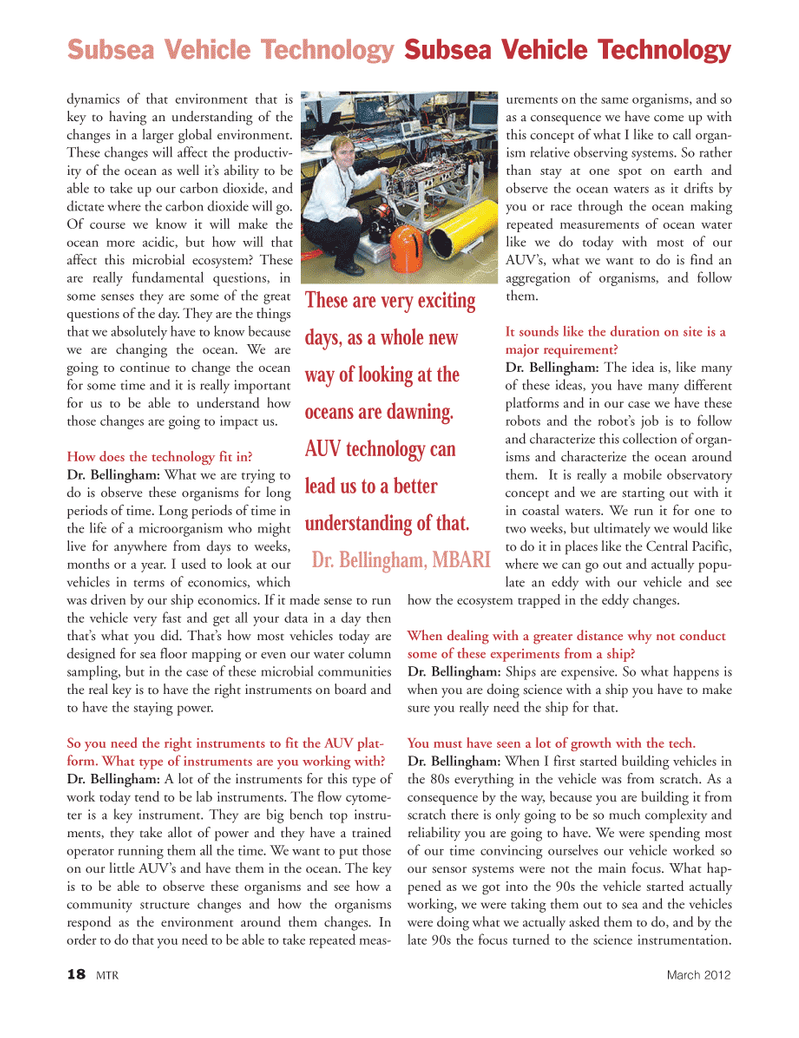
Page 18: of Marine Technology Magazine (March 2012)
Subsea Vehicle Report – Unmanned Underwater Systems
Read this page in Pdf, Flash or Html5 edition of March 2012 Marine Technology Magazine
18MTRMarch 2012 dynamics of that environment that is key to having an understanding of thechanges in a larger global environment. These changes will affect the productiv- ity of the ocean as well it?s ability to be able to take up our carbon dioxide, and dictate where the carbon dioxide will go. Of course we know it will make the ocean more acidic, but how will that affect this microbial ecosystem? These are really fundamental questions, in some senses they are some of the great questions of the day. They are the things that we absolutely have to know because we are changing the ocean. We are going to continue to change the oceanfor some time and it is really important for us to be able to understand how those changes are going to impact us. How does the technology fit in? Dr. Bellingham: What we are trying to do is observe these organisms for long periods of time. Long periods of time inthe life of a microorganism who might live for anywhere from days to weeks, months or a year. I used to look at our vehicles in terms of economics, which was driven by our ship economics. If it made sense to run the vehicle very fast and get all your data in a day then that?s what you did. That?s how most vehicles today are designed for sea floor mapping or even our water column sampling, but in the case of these microbial communities the real key is to have the right instruments on board and to have the staying power. So you need the right instruments to fit the AUV plat- form. What type of instruments are you working with? Dr. Bellingham: A lot of the instruments for this type ofwork today tend to be lab instruments. The flow cytome- ter is a key instrument. They are big bench top instru- ments, they take allot of power and they have a trained operator running them all the time. We want to put those on our little AUV?s and have them in the ocean. The key is to be able to observe these organisms and see how a community structure changes and how the organisms respond as the environment around them changes. In order to do that you need to be able to take repeated meas- urements on the same organisms, and so as a consequence we have come up with this concept of what I like to call organ-ism relative observing systems. So rather than stay at one spot on earth and observe the ocean waters as it drifts by you or race through the ocean making repeated measurements of ocean water like we do today with most of our AUV?s, what we want to do is find an aggregation of organisms, and follow them. It sounds like the duration on site is a major requirement? Dr. Bellingham: The idea is, like manyof these ideas, you have many different platforms and in our case we have these robots and the robot?s job is to follow and characterize this collection of organ- isms and characterize the ocean around them. It is really a mobile observatory concept and we are starting out with it in coastal waters. We run it for one to two weeks, but ultimately we would like to do it in places like the Central Pacific, where we can go out and actually popu- late an eddy with our vehicle and see how the ecosystem trapped in the eddy changes. When dealing with a greater distance why not conduct some of these experiments from a ship? Dr. Bellingham: Ships are expensive. So what happens is when you are doing science with a ship you have to make sure you really need the ship for that. You must have seen a lot of growth with the tech. Dr. Bellingham: When I first started building vehicles in the 80s everything in the vehicle was from scratch. As a consequence by the way, because you are building it from scratch there is only going to be so much complexity and reliability you are going to have. We were spending most of our time convincing ourselves our vehicle worked so our sensor systems were not the main focus. What hap- pened as we got into the 90s the vehicle started actually working, we were taking them out to sea and the vehicles were doing what we actually asked them to do, and by the late 90s the focus turned to the science instrumentation. Subsea Vehicle Technology Subsea Vehicle Technology These are very exciting days, as a whole newway of looking at theoceans are dawning. AUV technology can lead us to a betterunderstanding of that. Dr. Bellingham, MBARI MTR#2 (18-33):MTR Layouts 2/21/2012 10:38 AM Page 18

 17
17

 19
19
